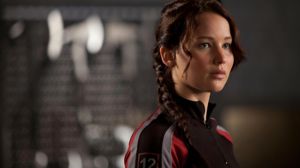As your first big gig in Hollywood, you really landed the jackpot. First, you got to be the envy of your jealous friends, who undoubtedly tried to claw out every detail of how the filmmakers would adapt Suzanne Collin's wildly popular novel The Hunger Games. More importantly though, while you were busy running around getting coffee for the editors, colourists, and data managers, I hope you picked up a little something for yourself: like a lesson in how the pressures of catering to a rabid fan-base doesn't have to result in pandering to a common denominator.
But that doesn't mean the producers didn't fight hard to sell this is a family-friendly adventure flick. Luckily, a story about teenagers forced into a battle royale death match can only be sanitized so much. And you can't alienate your core audience, who, like the citizens of Panem, want their blood, but can be won over by an unlikely love story. To pull this off, the film would need a sparkle of Twilight's romance, a world as vivid as Harry Potter's, and moments of moral cynicism that could have come straight from the back alleys of Gotham city.
These are all decisions that are laboured over during scriptwriting and shooting, but the last word always rests in post-production. You're like the film's own sinister Gamemakers, who have the ability to twist and amend events in whatever way suits the studio's final agenda. And you won.

The film earns its PG-13 rating by respecting our imagination. Shaky camera work, in the popular Paul Greengrass mode, provides an aura of violence without ever being explicit. In fact, the post-production treatment often abstains altogether from sound and gore, to maximum effect. If you grew up attending the Michael Bay school of action, I'm sure you thought the speakers in the editing room were broken when you first saw the Cornucopia slaughter that opens the games. Saving the visual theatrics for the story's climax is one of the smartest decisions in the film.
I'm sure nobody worried about cutting around Jennifer Lawrence's performance as Katniss. Beautiful, soulful, intense; she has a face that seems to transform from scene to scene, depending on lighting and angles; we never feel like we know what to expect from her. From her shattered scream of volunteering for the Games, to her strained expressions as she tries to figure out how to play to the crowd during her pre-Game interviews, Lawrence is the anchor we need to sustain our interest. Unlike the book's first-person narrative (ever spelling out her motivations) her performance only requires a simple glance of uncertainty, or mistrust, or determination to draw us in. Voiceovers be damned.

I do imagine, however, that there were some lengthy debates made in post-production about the use of Caesar Flickerman and Claudius Templesmith. Only a couple times did the narrative resort to their play-by-play in order to elaborate on diegetic specifics (like the deadly tracker jackers). For a concept that is essentially about a reality show, it would seem a natural fit to shift the narrative focus to the television viewer's perspective to help us fill in the blanks. Woody Harrelson certainly manages to do a lot with his minimum time on screen, but his Haymitch character, who mentors the kids and sweet talks sponsors into getting them gifts, felt like a natural place to expand the storytelling circle. Instead, a quick dialogue-free shot informs us he's working behind-the-scenes on our hero's behalf. Less, again, proves to be more.
So there you have it, a killer resume credit and hopefully a window into what works in post-production. Nice work if you can get it, eh?
With Sugar,
Christopher







